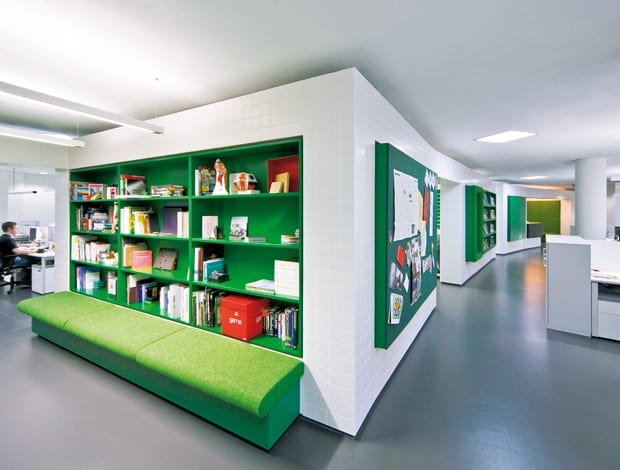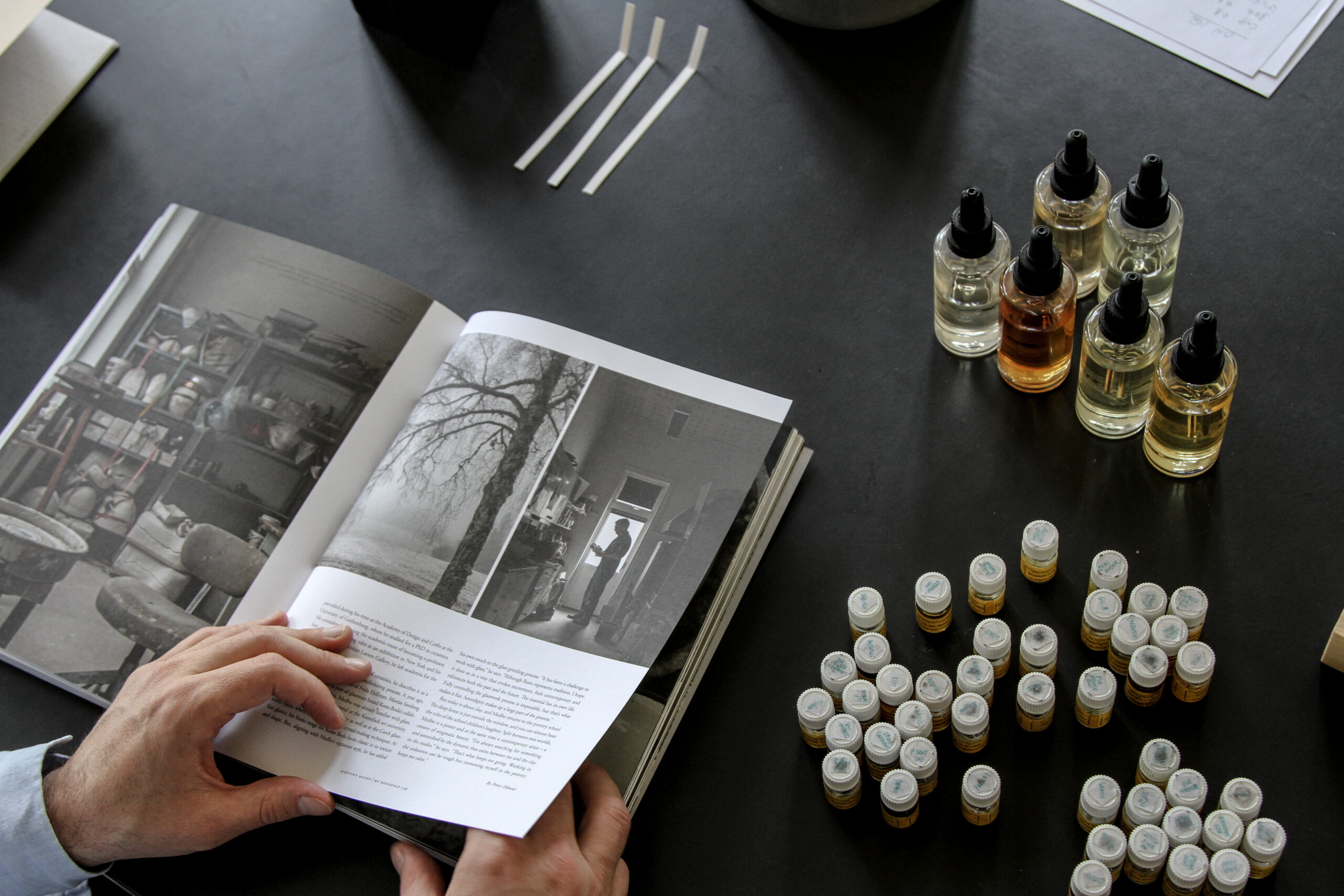 The main architectural feature of the office space is the spine. It features:prosmatic tiles by H&R Johnson; upholstered elements in fabric by Bute; a pinboard fabric from Kvadrat; Forbo Touch solo linoleum flooring; and Boule pendant lights by Regent Lighting|The floor plan|A 3D rendering of the spine, and the central functions it houses|Library bar with copper tiles by Metal Tiles and Golden Bell lights by Artek|Canteen with red painted picnic tables and Soft Dome lights by Habitat|Boardroom with Santa & Cole GT5 lights and Happy Chairs by Swedese||
The main architectural feature of the office space is the spine. It features:prosmatic tiles by H&R Johnson; upholstered elements in fabric by Bute; a pinboard fabric from Kvadrat; Forbo Touch solo linoleum flooring; and Boule pendant lights by Regent Lighting|The floor plan|A 3D rendering of the spine, and the central functions it houses|Library bar with copper tiles by Metal Tiles and Golden Bell lights by Artek|Canteen with red painted picnic tables and Soft Dome lights by Habitat|Boardroom with Santa & Cole GT5 lights and Happy Chairs by Swedese||
When Langland Advertising Agency took up residence next to Windsor Castle they called on Jump Studio to raise their game
The Royal Borough of Windsor houses Eton College, Ascot racecourse, the Queen, most weekends, and less expected, one of Britain’s top ad agencies.
Langland is a specialist in healthcare advertising campaigns, and has been steadily expanding since it began in 1991.
On moving in to the large, open-planned, single floor space at 55 High Street (the Queen lives at number 24), Joanna Chin, director of company development, had in clear sight where the agency should sit in the market. “When you walk through the door it shouldn’t matter the agency is in Windsor, or that it’s in healthcare.” Looking to create a space to leave the industry drooling, they called in Jump Studios, whose clients include Nike, Red Bull, Adidas and The Engine Group, and whose work they clocked through The Cool Hunter.
It’s the tile-clad spinal hub, which spans the slick, linoleum floored workspace, that really defines this project.
Mirroring the curved floor plate of the building, the curved spine runs through the centre of the office space, a singular designed element housing and networking all the office’s central facilities. At the very front is the reception, in the middle the library, in between the printing, the photocopying and the post room.
A central reservation houses files in alphabeticised pigeon holes; every client file is passed through the space, to be worked on by the creative team, based on one side of the spine, or the production team, on the other.
‘Plug-in features’ such as seats, storage and snugs encourage staff to interact with the area, whether it be browsing, storing or sitting. In the centre a designer’s resource area, kept stocked with fresh ‘tangible’ material, such as advertising products, paper stock, magazines, product designs and publications, is designed to draw the creative team away from their desks for non-digital inspiration.
“The spine is designed to be the heart of the office and of the organisation, as well as being at the centre of the building,” Markus Nonn, the project architect explains.
More importantly it pushes all the cellular space to the middle of the floor, freeing up the rest of the space to be open plan, spacious, clear and light. A cloakroom at the end of the office takes further clutter away from the desk space.
“The layout from the previous tenant put all the cellular space around the periphery, blocking out light, we really wanted to invert this,” Nonn explains.
The spine is finished in pure white porcelain tiles, with green tweed upholstery fabric as a soft counterpart.
Because the agency operates within the healthcare sector, the connotation with cleanliness and hygiene is there, but the colour scheme was chosen with a creative atmosphere in mind, not a clinical one.
The slightly disconcerting lack of clutter in this office is because ‘the system works’, Chin reckons, and although it’s early days (too early to accrue the usual mess) it is clear that the architectural layout does tie in the workflow and production process, at the same time as maximising on space and light.
“What we heard loud and clear from the consultations, was staff not wanting to feel cooped up”
“There was a lot of anxiety about going open plan,” Nonn adds, but as you can control the light and noise levels in each team area, there is still that feeling of personal ownership over space.
Also low-level storage benches between each work pod, create a ‘garden fence’ effect, where teams collaborate over drawings and sketches on shared worktop space.
A square graphic, based on the negative space of the spine, occurs throughout the office and with the use of tiles. Nonn describes the motif as a ‘conceptual thread’ that runs through the project.
Meeting and teleconferencing rooms occur for ‘ad-hoc’ use around the office space to avoid complicated booking systems. At the tea point there is one cup per staff member, that can be chalked on, ‘in Starbucks style’ with a name, an eco-cum-creative measure to encourage people to use the same cup each day.
Alongside from the smooth operations of the ad agency floor, the older part of the building houses the agency’s social spaces.
The front room, or library, for client and company use is an eclectic space that mixes boutique hotel with contemporary brasserie with traditional library.
The blue-grey paint is Farrow & Ball, the table is high lacquer black gloss, the chandelier is contemporary chic and the bar is copper tiled. “I have stopped buying things from eBay now,” Chin promises; one vintage furniture piece is from Hastings, another she collected from Church Street in Stoke Newington, London. Some antique pharmaceutical specimens hint at the nature of the company, as do the mixture of medical journals on the bookshelf. The space gives the sensation of domestic, work and social worlds colliding.
Next door, in the boardroom a similar merging occurs. Deep blue and maroon drapes complement dark wooden floors, the doorstops are Kelly Hoppen and the agency shares its seamstress with Eton College.
A bespoke boardroom table sits on one side of the room, with a circle of soft seating at the other, allowing a seamless transition from familiar to formal. “We can comfortably fit the fifty of us in here for company catch ups,” Chin adds.
The staff canteen, which is next along, sits somewhere between the Big Brother house and a sixth form common room.
The project was initiated with a consultation with everyone “from creative director through to caretaker,” on what their dream office would look like, Chin explains.
“What we heard loud and clear from the consultations, was staff not wanting to feel cooped up. Employees also wanted a free flow of culture, information, and influences in and out of the office. We distilled all the information into four main themes; the strongest being bringing the outside in.”
Playing on the theme, the canteen offers red painted picnic park bench style seating. The walls are super-sized blackboards, covered in creative scrawl, and standing internet access points dotted around facilitate facebook, twitter and hotmail fixes.
“It’s full at lunchtime, and for five o’clock drinks on Friday,” Chin explains, “we even find staff using it for poker nights.”
Next to the canteen/kitchen (desk lunches are not permitted) is a lounge area and massage chair. It’s a project that combines the aspirations, and organisation of the company, in neat tandem.























